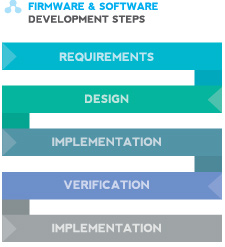
Firmware & Software Development

Seal develops firmware and software for the hardware in a start-to-finish process with the following key steps. After each phase is finished, it proceeds to the next one. Reviews occur before moving to the next phase which allows for the possibility of changes.
Planning
An important task in creating a software program is extracting the requirements or requirements analysis. Customers typically have an abstract idea of what they want as an end result, but not what software should do. Skilled and experienced software engineers recognize incomplete, ambiguous, or even contradictory requirements at this point. Frequently demonstrating live code may help reduce the risk that the requirements are incorrect. Once the general requirements are gathered from the client, an analysis of the scope of the development should be determined and clearly stated. This is often called a scope document.
Certain functionality may be out of scope of the project as a function of cost or as a result of unclear requirements at the start of development.
Implementation, testing and documenting

Implementation is the part of the process where software engineers actually program the code for the project.
Software testing is an integral and important phase of the software development process. This part of the process ensures that defects are recognized as soon as possible. Documenting the internal design of software for the purpose of future maintenance and enhancement is done throughout development.
Deployment and maintenance
Deployment starts after the code is appropriately tested, approved for release, and sold or otherwise distributed into a production environment. This may involve installation, customization (such as by setting parameters to the customer's values), testing, and possibly an extended period of evaluation.
Software training and support is important, as software is only effective if it is used correctly. Maintaining and enhancing software to cope with newly discovered faults (bugs) or requirements can take substantial time and effort, as missed requirements may force redesign of the software.
